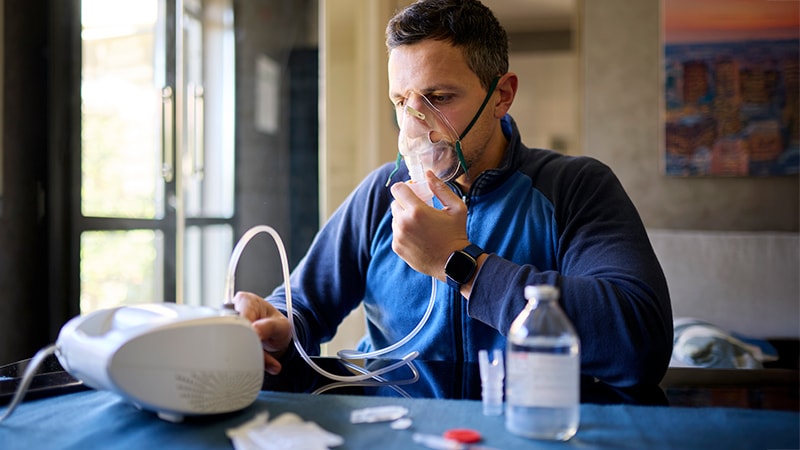Your patients with chronic obstructive pulmonary disease (COPD) may need help not just coping with their condition but also managing it in their workplace.
The symptoms of COPD, a lung and airway condition that causes shortness of breath, fatigue, and persistent cough, may interfere with some job responsibilities, according to several pulmonologists Medscape Medical News consulted as well as studies published in the past few years about COPD in the workplace.
The Mayo Clinic reported that symptoms for most patients with COPD begin when they are at least 40 years, so well into their working years.
Patients with COPD must continuously monitor if their condition affects their job performance and how potential workplace exposures to toxic chemicals or dust, and hazards such as stairs, worsen their breathing issues, the pulmonologists told Medscape Medical News.
Several recent studies evaluated how workplace exposures to gases, vapors, dust, and fumes raised employees’ risks of developing COPD, worsened their symptoms, or increased their chances of complications from the chronic disease.
To combat such outcomes, pulmonologists share ways they teach their patients about navigating their workplace environment, recognizing hazards, understanding workplace protections, and seeking help.
Weighing Work Options
Whether a COPD patient can keep up with the job requirements depends on the person and their worksite experience, said David Mannino, MD, a pulmonologist and chief medical officer for the COPD Foundation, and chair of the Department of Occupational Medicine and Environmental Health at the University of Kentucky, Lexington, Kentucky.
“Some jobs are more physically demanding than others,” he said. “Every patient has a unique situation and there’s never a one-size-fits-all approach. It’s very individualized.”
Mannino said he’s had patients who worked in coal mines or warehouses, and had to navigate those dusty and dirty environments, which can be difficult for patients with COPD.
If they can’t function reasonably well or keep up with the demands of the job, they may need to ask their employer for special accommodations such as switching to a different position or changing worksites, said Mannino, who sees patients several times.
“Some of my patients are on oxygen and that’s fine if you’re at a desk job. You can wear oxygen and that’s not a problem.” In other settings, it might be more difficult or impossible, he said.
“If you have a patient who is a woodworker and he is self-employed and he uses respiratory protection, that he can do reasonably well. I’ve had some older patients who work at the university in desk jobs and so they can continue to work with no real changes in their responsibilities or schedules.”
Some people with COPD may choose to retrain for careers where there aren’t as many physical demands, he said.
Mannino treated an older patient who was a plumber and could no longer keep up with some of the physical aspects of his job, so he was able to retire.
Environmental Triggers
Cleveland Clinic Pulmonologist Maeve MacMurdo, MD, said she spends time with patients with COPD evaluating their job, their challenges in the workplace with the disease, and potential triggers.
“So often people find that common triggers are things like strong perfumes or chemical cleaners,” she said. Incense and candles might also trigger COPD for some.
Weather also plays a major role in the lives of patients with COPD.
“The humidity definitely impacts a lot of patients, so the air quality is one thing I tell them, when you wake up in the morning, look at the humidity for the day,” said Rohan Mankikar, MD, a pulmonologist with NYU Langone Health, New York City. “The sweet spot for my COPD patients is like between 40%-70%, so if the humidity is above 70%, they might feel it more.”

On cold days, humidity < 20% might also affect patients with COPD, he said.
“But even days that it rains, snows, [they are] exposed to environmental changes such as wildfire smoke, I have patients that come in with COPD flares or exacerbations.”
Patients should also check the allergen, pollen counts, and the air quality index for the day, Mankikar said.
“This is just something simple they can do before driving to work because sometimes you drive with the windows down and you might be inhaling pollen. The job site could be construction and there’s exposure to dust,” he said.
Potential workplace hazards are myriad, he said. From copy machines that accumulate dust to beauticians who get exposed to different chemicals and smells, it all could possibly trigger an episode. Mankikar said some of his patients wear a mask when they can.
Patients should note what triggers their COPD and if it improves in different environments, Mankikar said. They should survey their work area to ensure it’s safe for them. For instance, the air quality or humidity in the room. If it’s a confined space with poor ventilation or an old building with mold that might require mold remediation.
One of the most important triggers to address is smoking, which is the primary cause of COPD, he said.
“That’s the biggest allergen for them and they might not realize it because they’re saying: ‘Well I’m used to this and did this [most of] my life.’ But it weakens the immune system when you’re actively smoking and creates more mucus production, which then acts like a glue for dust and pollen exposure.”
Workplace Protections
The Americans with Disabilities Act (ADA) protects employees with substantial breathing difficulty and requires employers to provide “reasonable accommodations” or adjustments to the employee’s role.
Though the ADA doesn’t list specific medical conditions such as COPD, it considers breathing a physical impairment that substantially limits or restricts a major life activity covered under the act. Major life activities include respiratory functions along with performing manual tasks, working, learning, reading, thinking, and communicating.
To be protected, an employee must have a record of or be regarded as having a substantial impairment.
If an employee’s COPD stops or limits their ability to work effectively, they can apply for disability benefits through the Social Security Administration (SSA). COPD is listed among the respiratory disorders covered under the SSA’s list of covered impairments.
Monthly SSA disability benefits can be used to pay for food, clothing, housing, medical bills, medications, childcare, and training if an employee wants to return to work.
To qualify, the government requires medical evidence to document the severity of the respiratory disorder such as with pulmonary function tests, including spirometry, which measures ventilation of the lungs, or pulse oximetry, which measures oxygen saturation of peripheral blood hemoglobin.
What Help Patients May Need
In addition to portable oxygen, patients may have to request access to therapeutic options to help them perform their job functions, Mannino said. Those might include access to medications that can be used at work, such as handheld inhalers or nebulizers.
If a patient becomes short of breath when they climb stairs and that’s a job requirement, they may have to ask their employer to modify their duties or look for another position within the company, resign or retire, he said.
It’s up to the employer to decide whether the request for accommodation is reasonable, Mannino said. If you’re a welder and you need to be on oxygen, that’s not really safe because it can create a fire hazard, he said.
“I think employers want to typically work with their employees…and that it’s possible to make the workplace better for that person who has COPD.”
If the company has an occupational health specialist in their human resources department, they may be able to assess the employee’s needs and offer suggestions, said Francesca Polverino, MD, PhD, a pulmonologist and medical spokesperson for the American Lung Association.
For some employees, access to a wheelchair may help them navigate the distances they might have to traverse at work, especially if they are carrying oxygen, said Polverino, who is also a professor of medicine at the Baylor College of Medicine.

Patients with COPD also would benefit from further education of their coworkers and supervisors about the disease because there’s often a stigma associated with it, Polverino said. Compared with asthma, which tends to be inherited or unintentionally acquired, COPD is often caused by a preventable addiction — smoking.
It’s also not considered as alarming as other chronic diseases because COPD worsens slowly over a longer period, she said. For these reasons, workers with COPD may be reticent to ask for help, she added.
MacMurdo said “reasonable accommodation” from an employer might include a private office, an air purifier, working from home or having a flexible schedule. She agreed that not all work adaptations will be possible, but employees can brainstorm solutions with their doctors.
Patients should keep a log of what they are doing and when they experience symptoms to help doctors identify triggers and come up with workarounds they can suggest to their employers, MacMurdo said.
Ideally, patients should discuss with their doctors what they recommend and decide what’s practical for the particular job to control COPD symptoms, she said.
How to Ask for Help
Mankikar said he’s written letters for patients to take to their employer asking if it’s possible for them not to be exposed to certain chemicals or dust that might exacerbate their COPD.
“For example, if the patient is a teacher and has COPD and they’re doing construction [nearby], then I might have them try to teach a different class that’s away from the construction site, so they’re not in the hallways inhaling the dust.”
Patients often request a doctor’s note to leave early from work for pulmonary rehabilitation, Mankikar said.
“Unfortunately, those facilities are only open Monday through Friday from 9 to 5…so that’s an example of writing a letter to make that accommodation happen to strengthen their lungs.”
Employers tend to be very responsive to his notes, he said.
“The moment they know that some of these dust exposures can increase their [employee’s] risk of COPD they want to make accommodation for them because they don’t want the employee to miss work due to the illness.”
Employers know that if their employees are exposed to chemicals or allergens, there’s also a financial burden they might face, Mankikar said.
If the employer is willing to work with the patient, they might move them to an administrative role instead of a direct occupational one. He cited a patient who worked for a landscaping company and managed other landscapers. The exposure to allergens raised his risk for COPD flareups, so his employer agreed to move him to an area that’s well-ventilated and on days when the pollen count was high, he was able to work at a different site.
These resources also may help patients navigate COPD in the workplace:
- How to Manage COPD’s Impact on Your Job
- Early Warning Signs of Work-Related COPD | American Lung Association
- Lung Health on the Job | NHLBI, NIH
Roni Robbins is a freelance journalist and former editor for Medscape Business of Medicine. She’s also a freelance health reporter for The Atlanta Journal-Constitution. Her writing has appeared in WebMD, HuffPost, Forbes, New York Daily News, BioPharma Dive, MNN, Adweek, Healthline, and others. She’s also the author of the multi-award-winning novel Hands of Gold: One Man’s Quest to Find the Silver Lining in Misfortune.
